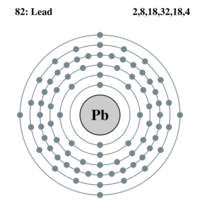Difference between revisions of "Lead"
(ref) |
|||
| Line 11: | Line 11: | ||
</div>]] | </div>]] | ||
| − | [[Anthropogenic]] use of lead in metallic from (battery casings, lead pipes) are usually recycled. However lead used as petrol additives are largely lost to the atmosphere. This lead enters the marine ecosystem globally though rain. However coastal areas with a lot of near shore automobile activity can have considerably higher lead contamination. The reduction of leaded gasoline in the last decades caused the surface concentrations of lead in the North Atlantic surface waters to decline by 50% between 1981 and 1989. | + | [[Anthropogenic]] use of lead in metallic from (battery casings, lead pipes) are usually recycled. However lead used as petrol additives are largely lost to the atmosphere. This lead enters the marine ecosystem globally though rain. However coastal areas with a lot of near shore automobile activity can have considerably higher lead contamination. <ref name = c>Clark, R,B., 1999. Marine pollution. Oxford University press, Fourth edition, pp 161</ref> The reduction of leaded gasoline in the last decades caused the surface concentrations of lead in the North Atlantic surface waters to decline by 50% between 1981 and 1989.<ref name = ken>Kennish, M. J. (1996): Practical Handbook of Estuarine and Marine Pollution, CRC Press 524 pp</ref> |
| + | |||
| + | Compared with other heavy metals, lead in the sea isn't particularly toxic. So can some organisms [[bioaccumulation|accumulate]] high concentrations of lead without any apparent harm. In polluted areas barnacles can accumulate up to 100 ppm (parts per million) and mussels in Norway have been shown to contain up to 3000 ppm of lead. | ||
| + | These mussels have a detoxifying mechanism for lead; they can store large quantities as granules (solid form) in their digestive gland (an organ that helps digest food). However, environmental concentrations above 10 ppm (parts per million) are shown to be detrimental for the growth of some organisms (some crustaceans and algae).<ref name = c>Clark, R,B., 1999. Marine pollution. Oxford University press, Fourth edition, pp 161</ref> | ||
Revision as of 11:16, 24 July 2009
Definition of lead:
Lead is a heavy metal with symbol Pb and atomic number 82.[1] It has a bluish white color, when freshly cut, but tarnishes to dull gray when exposed to air. It is also highly malleable. [2]
This is the common definition for lead, other definitions can be discussed in the article
|
Notes
Anthropogenic use of lead in metallic from (battery casings, lead pipes) are usually recycled. However lead used as petrol additives are largely lost to the atmosphere. This lead enters the marine ecosystem globally though rain. However coastal areas with a lot of near shore automobile activity can have considerably higher lead contamination. [3] The reduction of leaded gasoline in the last decades caused the surface concentrations of lead in the North Atlantic surface waters to decline by 50% between 1981 and 1989.[4]
Compared with other heavy metals, lead in the sea isn't particularly toxic. So can some organisms accumulate high concentrations of lead without any apparent harm. In polluted areas barnacles can accumulate up to 100 ppm (parts per million) and mussels in Norway have been shown to contain up to 3000 ppm of lead.
These mussels have a detoxifying mechanism for lead; they can store large quantities as granules (solid form) in their digestive gland (an organ that helps digest food). However, environmental concentrations above 10 ppm (parts per million) are shown to be detrimental for the growth of some organisms (some crustaceans and algae).[3]- ↑ http://en.wikipedia.org/wiki/Lead
- ↑ http://glossary.eea.europa.eu/terminology/concept_html?term=lead
- ↑ 3.0 3.1 Clark, R,B., 1999. Marine pollution. Oxford University press, Fourth edition, pp 161
- ↑ Kennish, M. J. (1996): Practical Handbook of Estuarine and Marine Pollution, CRC Press 524 pp

